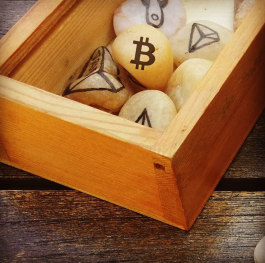
Thought I’d add a primer or introduction to cryptocurrency in general and its growing ‘universe’ here in April 2019.
Buying, storing and sending cryptocurrency are in fact all very easy processes, and completely reliable by simply copying and pasting a public address, or using smartphone ‘tools’ like QR code, fingerprint ID etc. It’s all pretty straight-forward and all cryptos work basically the same way with a few exceptions where memos and named addresses are used instead of a string of numbers and letters. I’ll cover this more in the next post, but for now….
What to Buy?
What is more confusing is knowing which cryptocurrency to invest in, as this is their major role right now, although new integrations, partnerships, use-cases and developments are occurring daily that are keeping various cryptos from being bought and sold more than others.
DLT or Distributed Ledger Technology is a rising umbrella term because cryptocurrencies are merely the medium of exchange that secure various networks, mostly blockchain-based ones. There are other types of networks for example: DAG (Directed Acrylic Graph) or blends, that may one day prove themselves more at scale. Any of these networks can be easily integrated with the internet (via websites, browser extensions etc.) but are in fact completely separate transaction-focused ‘internets’.
The one thing to bear in mind is: Change. This is the most constant thing when investing beyond the first or second cryptocurrency by market cap. Besides keeping some Bitcoin (BTC, a.k.a XBTC) – the safest, most robust and generally the most stable crypto of them all – the thing to keep in mind is… that you should keep your mind open and embrace change. You will adjust your portfolio. New information comes to light; new developments; some negative, mostly positive, since this is a rising technology. There is plenty of room in the crypto-verse for a number of crypto projects, some of which are similar, but most very different from each other under the hood.
It’s all a question of knowledge, plus a personal perspective, but, as ever, the learning curve is more interesting when accompanied by personal investment, however small. It doesn’t need continual vigilance. We’re talking about large networks in many cases, with solid communities behind them. Long-term holding (‘hodling’) is ideal, but you will simply find yourself changing sides, the more you learn. Hopefully, following this blog could help you get a head-start.
One thing will become clear, as it has to many (but not everyone yet): The Internet of Value is arriving, and the token ecosystems that will emerge will be fascinating places to visit.
But yes, another important thing to bear in mind is that we’re still partly on a road which is changing, or unknown. The market is tied into a cycle of rapid rises and falls but is also seeing substantial growth. Many coin projects are still experiments besides the few that have already proven themselves. Some that have great tech may take years to reach a more adopted position. Some with much-needed development have achieved adoption that will keep them ahead of the game – and in line for development – for many years to come. There is a race, to an extent, but there will be many winners across the board. It is not easy to determine value, especially when so many projects are tied to Bitcoin’s price.

Levels of Decentralisation – important?
What makes Bitcoin (BTC) so trusted is that it’s open and decentralised. We’re talking public blockchains here, usable or mine-able by anyone, not private blockchains like some FacebookCoin or JP Morgan Coin or fiat ‘stablecoin’, potentially more hackable or controllable by their creators or various interested parties. Decentralised or distributed ledger tech – for the first time – offers us the promise of a currency that exists beyond centralised control or manipulation. Anyone can participate in securing BItcoin’s network, at a cost external to the network: electricity.
‘Maximalists’ remain devoted to BTC as the one true crypto, while others would say that BitcoinCash (BCH), a fork of the original Bitcoin code, is where it’s all headed. But Bitcoin has taken its time to achieve its market dominance. Right now it’s the sun that all other projects are pulled around – until something happens to change this. Meanwhile, inherent change comes slowly to Bitcoin development, like a language, they must be widely adopted – although new, faster solutions (such as the Lightning Network) can arrive more quickly, but with some drawbacks too.
So is this ‘decentralised’ aspect important? Well, that’s where the uncertainty and debate come in. But, so far, BItcoin has stood the test of time, where other cryptos have suffered network-threatening attacks. Some argue that all cryptos today are badly designed, because they are not purely distributed. They are only decentralised. A truly distributed network would allow for 0 transaction fees, with no major (centralised) participants – even miners – influencing anything. Everyone would operate as a ‘node’. In such a collaborative, open system, no incentivised parties would ideally be involved. It would be immune from any form of manipulation.
But… how would this network achieve adoption, how would anyone be incentivised to participate – just via the speculative future value of its token? Maybe these days enough funds could be raised from the outset. Then, how would ‘bad actors’ be filtered out? How would mistaken transactions be reversed? There are many exciting solutions and protocols like this that have been adopted by many or only by a few so far. There are protocols like Proof-of-Authority (VeChain) that mix in some centralisation by necessity, or protocols that use ‘gossip’ to reach consensus or a unique time-stamping protocol. Just as interesting, there are networks whose very protocol for achieving consensus (the validation of entries) lies open to future change by their communities (Tezos).
This is wise, for where there are applications running, how is a network to be governed effectively, without manipulation or collusion? For networks running social media projects even with strong communities overseeing censorship via voting, surely it would be wise to have some means of quick intervention?
The answer is that there is more than one answer for a network to function effectively, and the most effective solution depends on what that network was designed for. Bitcoin functioning securely as a currency should have little governance. EOS (a rising platform) is progressing rapidly with its number of dApps, but it may need to alter its own governance to respond more effectively to questionable incidents arising. They may need to revoke the existence of some dapps if they hold negative potential, or lead the network into ‘difficult’ territory.
Also, there are some very unique, distributed networks such the Tangle from IOTA, and Nano’s similar DAG tech, that promise much, but they still need to prove themselves at scale, and for their application with the Internet of Things, or for currency transactions as secure as what Bitcoin enables. They must prove how they can avoid both attack and manipulation.
Goodness evolves
But, where no-one knows the future, it’s important to think about where we are today, what is being used and adopted, and how is development coming along.
Today, Bitcoin can function both as a payment solution and a store of value, like gold (and also for some dApps). Yes, it’s wasteful in terms of electricity, but who’s to say this can’t evolve? Can any crypto ever challenge the reliability of Bitcoin, ‘the people’s money’? It is now well-loved, highly embedded across the space and internet, and every other project owes it a debt for their very existence.
Decentralised Finance (De-Fi)
The future will likely see more cross-chain solutions arriving, allowing this diversity of networks to interchange their value and grow in adoption and use. Many could see problems with their governance or protocols, but diversity will ensure that some are more suited for a purpose than others. There will be no ‘one-shoesize fits all.’
This introduction ends, but be sure to check some essential videos, besides more starter processes. You can check out and follow my own portfolio if you wish, where many exciting projects feature on this site.
There is no point in supporting one project 100% in cryptocurrency or investment, because sooner or later your opinion or perspective may change. But you may return to it again.
Arguably the best investments to make right now are related to the more constant demands or potential in cryptocurrency today: exchange tokens, or the large blockchain platforms for dApps (decentralised applications). There are also exciting websites with promising, individual token ecosystems ready to disrupt huge areas of business if their tokens can grow in value. There is big growth potential on the cards here, no doubt about it. So be prepared to spread some well-placed bets, which may not be bets at all, in the long-term. More like gems, to the simply well-informed, inquisitive eye.
April 2019. Disclaimer: Nothing in this blog is professional investment advice. I have been holding, trading and learning about cryptocurrency since January 2018.
See also: Types of Cryptocurrencies and Videos…
Goto NEXT: CRYPTO PRIMER 2: Buying and Storing Your Crypto and Tokens…

